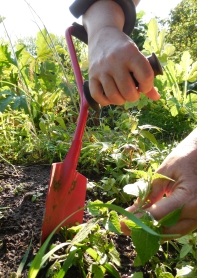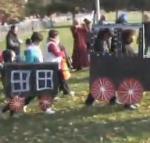
346 Lansdowne Avenue, Toronto
MacGregor Park
Accessible - Inclusive - AND - Barrier Free
Teaching and Community Gardens
.
Introduction -
Including Everyone in the Benefits of Community involved Gardening
.

The Benefits for Everyone
- While growing and sharing your own local, fresh food is a major reason for joining a community garden, there are many other benefits.
- One important benefit is the social aspect of a community garden, where people from diverse backgrounds can share their gardening experience. It is a great joy to see the bright faces of new gardeners who just harvested their first radishes!
- Physical activity is also an important component of gardening, and being able to maintain a certain amount of agility can promote long-term health. This is especially true for our aging population, and can also help get our children off to a healthy start.
- Everyone can benefit from gardening to reduce stress. Having the ability to choose your own seeds, and having your own plot of land or planter, fills our need to nurture and care for life.
.
These are just some of the key benefits of gardening—and why the Toronto Community Garden Network supports a myriad of community efforts, and supports the MacGregor Park in creating their teaching garden.
.
- HOWEVER -
Not Everyone Benefits – Yet
.
The Toronto Community Garden Network hopes to raise awareness of the full spectrum of access issues. Our aim is to encourage community gardens in Toronto to be even more inclusive and mindful of those with special needs.
.

Access is about:
- Growing good healthy food - despite any financial challenge
- Creating gardens that support people with a range of physical and mental health abilities
- Creating safe social spaces for people suffering isolation so they can meet new friends and get to know the community
- Showing children where their food comes from and helping seniors pass along their gardening tradition
- Demonstrating that gardening methods are not just for the physically heroic - such as no-till
- Providing different opportunities to garden which fits in with urban life.
- This can include perma-culture, container planters and sensory gardens
Understanding the real needs of those in your community is our goal - just building a raised garden bed won’t always be the answer.
.
Being Inclusive In The Teaching and Community Gardens will lead to:

- increased understanding of each others abilities,
- increased understanding of the requirements and strategies for accessibility,
- healthier fitness levels,
- improved self-esteem and self-confidence,
- augmented skill development that leads to enhanced independence,
- deepened understanding of different perspectives,
- heightened appreciation of nature,
- increased friendships and support networks, and
- enhanced opportunities to experience satisfaction and enjoyment.
Barrier free gardens
Barrier free gardens are gardens that are designed in such a way that all people in your neighborhood can participate. Check your garden design for elements that may create barriers which could prevent people from participating in the community garden. There are basic steps you can do to make your garden physically accessible!
.

What is a barrier?
A barrier is anything that prevents an individual or group from participating in community gardening. Three main barriers may be physical, cultural or language barriers
.
What are examples of barriers?
- Having paths that are too narrow or bumpy that prevents wheelchair use
- Having fliers for events only in English, with writing above a grade six level
- Holding stereotypes about certain groups
- Not including any sort of raised beds
.
excerpts from:
- the Waterloo Region "Together 4 Health" website together4health.ca/ - Making Your Garden Accessible
- Barrier Free Gardens - Guide.pdf
. And
- and the Utah Conservation Corps website www.usu.edu/ucc/ Disability Inclusive Crew
- Inclusion Toolkit
.




 Show search options
Show search options




 You are on the [Access-Aug2014] page of folder [Gardens]
You are on the [Access-Aug2014] page of folder [Gardens] For the cover page of this folder go to the
For the cover page of this folder go to the